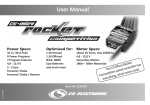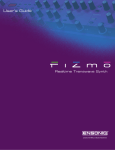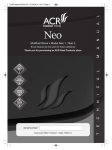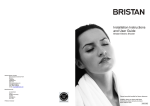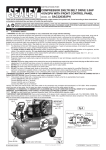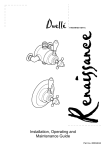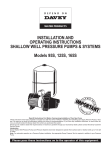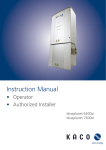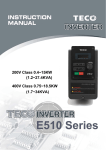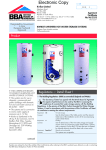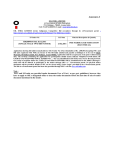Download STATIC CONVERTER – STC RANGE INSTALLATION
Transcript
STATIC CONVERTER – STC RANGE INSTALLATION & OPERATING INSTRUCTIONS (March 2002 revision) The TRANSWAVE converter offers no inherent overload protection to either the circuit cable or the motor. Adequate overload protection for both the motor and the supply circuit to the converter is the responsibility of the customer. The customer should also ensure that the electricity system and cable supplying the converter is of sufficient capacity to allow the motor to start without causing undue supply disturbances as a consequence of voltage drop. 1) Ensure that the details on the converter rating plate are compatible with the electricity supply system and the required motor loads. NOTE 2) The incoming supply should be connected to the converter via an isolator and protection device (i.e. fuse or circuit breaker). Recommended fuse ratings and cable sizes are indicated below. The output from the converter takes the form of an industrial-style three-phase neutral and earth socket (Notation: L1, L2, L3 N reading clockwise from earth). All earth connections should be securely connected to a good earth point. Removal of either the socket or the terminal box (if applicable) will compromise any warranty offered by the manufacturers. STATIC CONVERTER RATINGS CYCLIC LOAD SINGLE PHASE SUPPLY VOLTAGE 220/240 VOLT 440/480 VOLT Fuse Fuse Circuit Circuit Breaker Cable* Breaker Cable* Minimum Load Maximum Load Single Motor Maximum Load Multi Motor 0.37kw/0.50hp 0.37kW/0.50hp 0.75kW/1.00hp 0.75kW/1.00hp 0.75kW/1.00hp 1.10kW/1.50hp 1.50kW/2.00hp 0.75kW/1.00hp 1.10kW/1.50hp 1.50kW/2.0hp 3.00kW/4.0hp 4.00kW/5.5hp 5.50kW/7.5hp 5.50kW/7.5hp 7.50kW/10.0hp 11.0kW/15.0hp 1.5kW/02.0hp 2.2kW/03.0hp 4.0kW/05.5hp 5.5kW/07.5hp 7.5kW/10.0hp 9.2kW/12.5hp 11.0kW/15.0hp 15.0kW/20.0hp 13A 13A 25A 30A 40A 50A 60A 80A 2.5mm 2.5mm 4.0mm 4.0mm 6.0mm 10.0mm 10.0mm 16.0mm N/A N/A N/A N/A 20A 25A 30A 40A N/A N/A N/A N/A 4.0mm 4.0mm 6.0mm 10.0mm *Minimum size for run of up to 20m. For longer cable runs see current edition of BS7671/AS300 amendment 2. IMPORTANT Care should be taken with the connection of the machine to the output plug/socket. If the machine has a contactor starter the 400/415v-control coil must be fed from the phases marked L1, and L3. If the control circuit is fed incorrectly (i.e. connected to the phase marked L2) the contactor will either not operate or chatter when operating. Similarly, a control transformer and/or lighting transformer with a primary winding of 415v must be fed from the L1 and L3 phases. Connection to the L2 phase could lead to premature aging of the control transformer. The static converter can accommodate both a 415v control circuit (as above) and a single phase 240v control circuit provided the L1 phase is used in conjunction with the output Neutral. Multi-motor applications should be supplied from the converter output via a three-phase ring main or similar. 3) Before the output plug is inserted into the socket, switch the converter on using the on/off switch. The “supply on” light and the “boost on” light should both come on. Note that if the open circuit voltages were checked at this point phase to phase readings would be as follows. 400/420v between L1 and L3; 400/420v between L2and L3; No volts between L1 and L2. Note that the voltages do not relate to earth, as they would on mains three-phase electricity. Switch the converter off and insert the output plug. 1 IMPORTANT 4) Care should be taken with the setting of the powerregulating switch below the on/off switch. N.B. The 1.5kW unit has no on/off switch. The lowest setting corresponds to the minimum loading, the highest setting to the maximum loading of the converter. The ammeter indicates the current drawn from the single-phase supply to the converter. The initial surge required to start the motor is provided by the boost circuit of the converter. The “boost on” light indicates the circuit is energised. The circuit is controlled automatically from within the converter, switching on whenever a motor is ready to start and switching off once the motor has attained its full running speed. If the setting of the switch is too low the motor will struggle to start and the boost light will stay on. If the setting is too high the motor will sound rough when running, again the boost light may stay on. The optimum setting for a given single or multi-motor application is determined by quantifying the phase to phase voltages at the motor/starter with the boost light out and the motor(s) running.. Adjust the selector switch to the setting where these voltages are as close to 400/415 volt as possible. The best overall balance of voltages will correspond to the correct switch setting. Note that the voltages do not relate to earth as they would on a main three-phase supply system. If the rotation of the driven machine motor is incorrect, ensure that the converter phases marked L1 and L3 are changed for 415volt phase-phase control circuitry. For 240-volt phaseneutral control circuitry, ensure that phases L2 and L3 are changed If the boost light does not go out within a few seconds the machine should be switched off to avoid the possibility of electrical damage to the motor. The reason for this condition should be checked and corrected before the motor is restarted. Generally, the setting for the start and run modes of the motor will coincide. However for certain applications particularly those with high torque starting requirements it may be necessary to trim the switch back from a higher to a lower setting once the boost light has gone out to ensure a satisfactory balance of voltages for the running condition. For a multi-motor load, the largest motor should always be started first. An increase or decrease in load may necessitate an adjustment on the selector switch setting to accommodate the load variation. The boost light may switch on and then off when an additional motor is started. This is normal and may be disregarded. 5) The motor starting current is limited to approximately three times the full load current of the motor. The starting characteristics of a three-phase motor supplied by a converter are similar in nature to Star/Delta starting on a three-phase system. Significant reductions in starting torque are experienced when compared with direct on line starting on a three-phase supply. For machinery supplied by a converter, direct on line starting is recommend. For machinery fitted with Star/Delta starters, the period in the star connection should be as short as possible to ensure a successful start. 6) Where machinery incorporates ancillary motors of a fractional horsepower nature (e.g. table traverse/feed, suds/coolant pump, table rise/fall) it is imperative that these motors are operated in conjunction with and not independent of the main drive motor. Starters should be interlocked accordingly. 7) When using a converter with multi-speed machines, care should be taken to allow the motor to slow down before switching from a high speed to a low speed. Failure to do this could damage both the converter and the motor. Similarly when reversing a motor, ensure the motor is allowed to come to rest before the rotation change is effected. If either of these conditions is unacceptable (i.e. frequent stop/start, frequent forward/reverse, screw cutting) the use of a pilot motor may offer a solution (see below). The use of the Rotary converter is also recommended as an alternative. 8) For some three phase applications with small motors, motors of unusual magnetic characteristics (i.e. multispeed/reversing) or motors subjected to abnormal load conditions it may be necessary to connect a pilot motor in parallel to the driven machine to maintain a satisfactory artificial phase. In these instances, the pilot motor should be at least equal in rating to the driven machine, preferably larger. The use of a 2-pole (2800rpm) motor fitted with a starter and overload protection device is recommended. NOTE - The output from a TRANSWAVE Converter cannot be compared directly to a mains three-phase electricity supply. The TRANSWAVE Converter offers an artificial means by which a three-phase motor (or motors) can be operated from a single-phase electricity supply. The TRANSWAVE Converter cannot be made to work equally on all motors, even though the horsepower, speed and voltage ratings are the same. Motors of differing manufacture and motors designed for differing applications vary considerably in their electrical characteristics. Therefore it is not always possible to make a universally applicable converter to operate a motor of given horsepower and rating. TRANSWAVE Converters are not designed for use in conjunction with continuous duty application. Manufactured and Supplied by POWER CAPACITORS LIMITED, 30 Redfern Road, Tyseley, Birmingham B11 2BH. England. Tel: 0121 708 4522 or 2811 – Fax: 0121 765 4054 - Email: [email protected] Website: www.powercapacitors.co.uk 2




